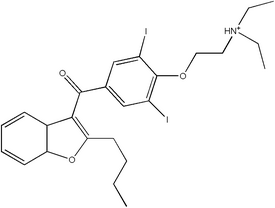To the Editor:
We are writing to highlight recent changes to the amiodarone (Cordarone; Wyeth-Ayerst; Philadelphia, PA) package insert (ie, product label). The label, as approved in 1986, states that amiodarone is indicated for the treatment of life-threatening, recurrent ventricular dysrhythmias in situations in which there has been no response to alternative agents or when those alternative agents could not he tolerated. The label further states that the frequency of pulmonary toxicity (ie, hypersensitivity pneumonitis and interstitial/alveolar pneumonitis) in retrospective cohorts at doses of 400 mg per day has been estimated at 10 to 17%, with fatality occurring in about 10% of cases. Although the acuity of the amiodarone-associated pulmonary toxicity was not directly specified in the initial product labeling, spontaneous adverse event reports ("MedWatch" reports) received by the US Food and Drag Administration (FDA) and reports from the medical literature, which were highlighted in a review by Ashrafian avid Davey, (1) suggest that amiodarone-induced lung toxicity may develop within days to weeks of the initiation of therapy.
>From the initial marketing through December 2002, the FDA received approximately 2,000 domestic, clinically serious adverse event reports in association with amiodarone. (In this ease, clinically serious is defined as an outcome of death, disability, or hospitalization [initial or prolonged] that is life-threatening or requires intervention to prevent permanent impairment/damage.) Based on the Medical Dictionary for Regulatory Activities coding, the most frequent events to be included among these reports were dyspnea (264 reports), pneumonia (178 reports), lung disorder not otherwise specified (173 reports), and pulmonary/fibrosis (161 reports). The total number of reports received by year (1,941), including the subset of reports (hatched bar) coded for any parenchymal lung injury (280 reports), is shown in Figure 1. Absolute report counts of parenchymal lung injury have increased to remain in proportion (14% on average) with increases in all clinically serious reports for amiodarone. Spontaneous reports submitted/collected by the FDA represent an unknown fraction of all incident eases, but a frequency of 1 to 10% has been suggested. (2) Thus, the actual number of amiodarone-associated adverse events may be larger (by 10-fold to 100-fold) than the counts presented herein. However, an increasing number of report counts over time does not necessary mean that the rate of clinically serious reports is increasing, as these counts are unadjusted for use and might simply reflect increasing use. (Due to the large numbers included in this analysis, unreviewed (ie, crude] report counts have been used in lieu of reviewed "case counts," and thus may include duplicate eases or eases in which the association between an event and amiodarone is unknown.)
In consideration of these and other data (3,5) of amiodarone-associated parenchymal lung injury, the Cordarone label was updated in April 2003 to include the following statements. "There have been reports of acute onset (days to weeks) pulmonary injury in patients treated with oral Cordarone with and without initial IV therapy. Symptoms included pulmonary infiltrates on radiograph, bronchospasm, wheezing, fever, dyspnea, cough, hemoptysis, and hypoxia. Some cases have progressed to respiratory failure and/or death. Patients with preexisting pulmonary disease have a poorer prognosis if pulmonary toxicity develops. Use of a lower loading and maintenance doses of amiodarone may decrease the incidence of amiodarone-induced pulmonary toxicity."
Allan Brinker, MD, MS
Michael Johnston, RPh
Food and Drug Administration
Rockville, MD
REFERENCES
(1) Ashrafian H, Davey P. Is amiodarone an underrecognized cause of acute respiratory failure in the ICU? Chest 2001; 120:175-282
(2) US General Accounting Office. Adverse drug events: the magnitude of health risk is uncertain because of limited incidence data. Washington, DC: ITS General Accounting Office, 2000; Publication No. GAO/HEHS-00-21
(3) Donaldson L, Grant IS, Naysmith MR, et al. Acute amiodarone-induced lung toxicity. Intensive Care Med 1998; 24:626-630
(4) Goldstein I, Topilsky M, Segev D, et al. Very early onset of acute amiodarone pulmonary toxicity presenting with hemoptysis. Chest 1997:111:1446-1447
(5) Ott MC, Khoor, Leventhal JP, et al. Pulmonary toxicity in patients receiving low-dose amiodarone. Chest 2003; 123: 646-651
Reproduction of this article is prohibited without written permission from the American College of Chest Physicians (e-mail: permissions@chestnet.org).
Correspondence to: Allen Brinker, MD, Office of Drug Safety, Center for Drug Evaluation and Research, Food and Drug Administration, 15B-08 HFD-430, 5600 Fishers Ln, Rockville, MD 20857; e-mail: brinkera@cder.fda.gov
COPYRIGHT 2004 American College of Chest Physicians
COPYRIGHT 2004 Gale Group



